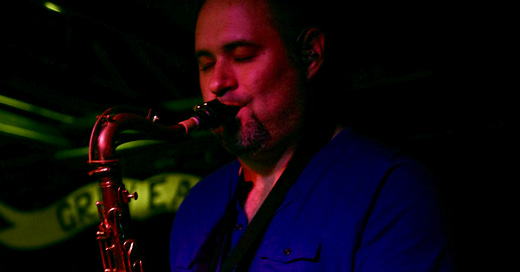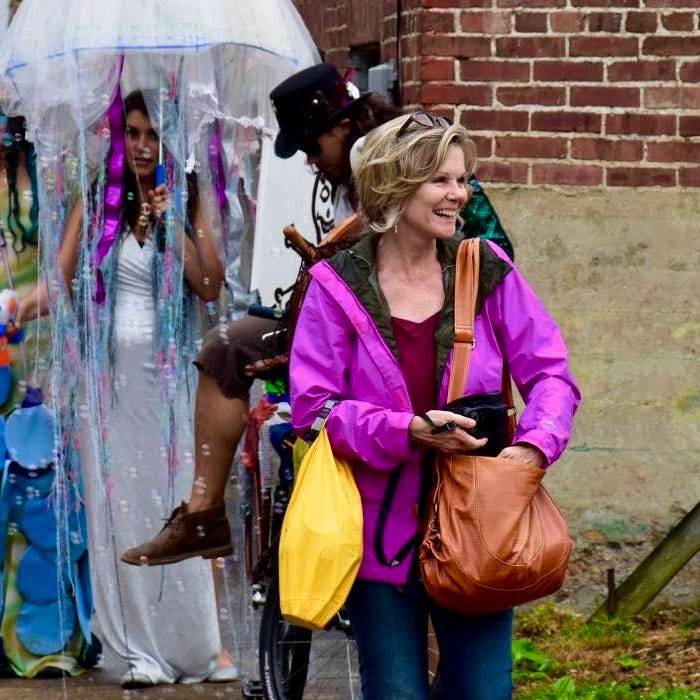The art research assignments Martin had provided me were just a way to pay me small amounts periodically and help keep me, at least tangentially, on the documentary team.
But, as a documentary filmmaker, what he was most interested in were my fundraising skills. During the night of the WNVT auction, I’d told him how much money I’d raised for the station. I once read that documentary filmmakers spend as much as 80% of their time trying to fund their projects, and 20% of their time actually making them – a statistic that made Martin wince out loud when I shared it with him.
His film on Thomas Jefferson was mostly funded. But Martin had another idea that he needed financial support for – the history of news in America, from the first colonial newspapers to present day. He was a passionate collector of vintage newspapers himself, periodically going to shows and picking up archival documents of interest.
We brainstormed ideas for where and how to raise money for what he envisioned as a series – his first. In the world of documentary film – as I was to learn over and over – fundraisers rarely get paid a salary for their efforts. Filmmakers don’t have a lot of cash on hand and if they do, it’s considered risky to spend it on fundraisers, even though they need them. On the other side of the coin, it’s considered risky to spend your hours and days trying to bring money in to fund projects with no compensation for your time or efforts. 99% of the time, it’s a lose/lose situation. But I was optimistic about the 1%.
And so, mostly because I still wanted to be a part of the documentary workshop, I agreed to try and find funding for the news series, on what the British might refer to as the ‘never never.’
The series didn’t have a working title yet, so I suggested “News & The American Character” which Martin liked, and which made it easier to catch people’s attention. It was a story that needed to be told and a perfect fit for PBS. And with his degree in broadcast journalism from Boston University, Martin would have been a good person to tell it.
Anxious to get results (and get paid), I set to work. Lots of leads, but no positive results. I even arranged a meeting with Peter Prichard, director of the Newseum, an exciting new museum dedicated to news and journalism that promoted free expression and the First Amendment, while tracing the evolution of communication. A perfect fit, I thought. Peter gave us a great tour of their facilities but as his organization was also in fundraising mode himself, he was unable to help us financially. Over the course of the following year, Martin compensated me for my phone bills but lacked the funds (since I hadn’t raised any) to compensate me for my time.
Meanwhile, Steve and I continued to limp along financially, which was stressful for both of us. Steve continued plumbing, along with half a dozen other side ventures, while I tried to raise money and paid gigs for artists, illustrators, musicians and arts organizations, working from home so I could be with the kids. MENC, the Music Educators National Conference, a national organization of music teachers, was my best client and only actual income at the time. The director and I got along well. I designed some crazy fun innovative corporate strategies for them, all of which he loved, but none of which resulted in hard cash over the course of the next year. Eventually, he was pressured by his board to end our contract, which he reluctantly did, and with the loveliest and most gracious termination letter ever.
In the course of my efforts on the money trail, I’d heard about a new organization called Business for Social Responsibility – a group of socially minded entrepreneurs formed in 1991 to represent the voice of progressive businesses in policy formation in Washington, DC.
In 1993, BSR had its first annual conference in Washington DC featuring Ben Cohen –the Ben of Ben & Jerry’s; Anita Roddick, founder of The Body Shop; and Gary Hirshberg, cofounder of Stonyfield Farms, the first dairy processor to pay farmers not to treat their cows with synthetic growth hormones. (In the years to come, Stonyfield would go on to help create the Oscar-nominated documentary, Food, Inc. – a staggering look at what really goes on inside America’s corporate food industry.)
Three hundred people attended the first BSR conference, and I was one of them.
Another attendee was keynote speaker, Bill Clinton – just a few months into his first term as President of the United States.
It was my third time being in the same room as Clinton. Steve, a passionate Democrat, had campaigned for him partly because of Clinton’s ideas and partly because they shared the same birthday – August 19th. Steve took that to be a sign of some sort and dedicated quite a few (unpaid) hours to the Clinton campaign.
When Clinton won, Steve managed to get tickets to one of the Inaugural Balls in town. I remember being surprised to learn there was more than one; I think there were at least a dozen of them in 1993. A lot of people, organizations, and special interests wanted to host or throw one in celebration of Clinton’s victory. We went to the one held at Union Station.
It was a Cinderella night for me. I’d found a sexy, brand-new-with-tags sequined evening dress in my size at a secondhand store for just $45. Having secured a trade-out in babysitting, Steve and I dressed up and hit the town for the night.
Bill and Hillary Clinton spent their celebratory evening racing around to make a personal appearance at as many of the Presidential Inaugural Balls as they could manage – something else I’d never been aware presidents had to do. When Clinton finally appeared at ours, late in the evening but still much to the crowd’s ecstatic delight, he thanked everyone, danced briefly with Hillary, then played saxophone on stage with the band.
Through his volunteering efforts, Steve also scored tickets to the coolest party in town – the “Absolutely Unofficial Blue Jeans Bash for Arkansas,” Clinton’s thank you party for Arkansas residents, which was a lot more fun.
“When Bill Clinton was elected President in 1992,” wrote Paste journalist Loren DiBlasi, “after 12 years of Republican rule, (people) just wanted to watch the totally chill former Governor of Arkansas jam on saxophone.” Looking back on that night, she later wrote the Blue Jeans Bash was “one of the more Clinton-esque events of the era.”
Held at the National Building Museum, it featured a Southern feast of catfish and hush puppies with music by Bob Dylan, Dr. John, Ronnie Hawkins, Levon Helm, and Clarence Clemens. Stephen Stills was there. Actors Don Johnson and Melanie Griffiths served as the evening’s hosts. Ben and Jerry, both dressed in jeans and tie-dyed T-shirts, served up scoops of ice cream for dessert.
“The whole state of Arkansas, it seemed, had turned up at the ‘Absolutely Unofficial Blue Jean Bash,’” wrote Martha Sherrill in the Washington Post. “Even Bill Clinton's mother, who was hugging everyone in sight.” (I’m pretty sure Steve got one.)
It was easy to tell who was from where. Everyone from Arkansas came dressed to the nines – rhinestones, sequins, make up and big hair. They were the glitzy party animals, exuberantly happy, drinking, laughing and dancing. Then there was the quiet Capitol Hill crowd tentatively hovering on the sidelines, dressed in Polo shirts, khakis and loafers. Steve and I avoided them, but had a blast hanging out with the Arkansas crowd.
In addition to Bill Clinton, the other big-name guest that night was Bob Dylan. Steve and I waited by the rails-and-ropes security guards had put out to hold guests sequestered away from the stage, impatiently waiting for Clinton to make his appearance. To pass the time, I attempted to chat with a middle-aged man from Texas standing next to me. Wearing a business suit and cowboy hat, he looked like he regularly enjoyed meals at expensive restaurants.
“Aren’t you happy he won?” I said in my naïve little buzz of happiness, somewhat starstruck by the whole event.
“Not really,” he drawled nonchalantly, taking me by surprise. “Ahh give equal amounts to both campaigns, so it doesn’t really matter to me who wins, as long as Ahh bet on the horse. And, Ahh always bet on both horses, so Ahh always win.”
End of conversation and, like a needle skipping across a vinyl record, a mind-jarring lesson in the realities of politics in Washington, DC.
Bob Dylan, apparently nervous people might get too close to him, stalled backstage as the crowd grew restless. When he finally appeared, it was anticlimactic. That night, it was Bill Clinton everyone wanted to see.
Dylan performed “To Be Alone with You,” a rollicking little dance tune from his album Nashville Skyline. But most of us were there to hear a little saxophone by the new president-elect and we eventually did, much to the whooping and hollaring delight of the entire rhinestoned crowd, cheering for their hometown boy.
What I remember most about watching Bill Clinton address the attendees at that first BSR gathering was his comfort and ease speaking to a crowded room, and his incredible memory for numbers and statistics. When someone from the back interrupted him with a question, Clinton stopped mid-speech.
“Hey, now that’s a good question!” he called out, acknowledging the person. He paused, sucking on his bottom lip for just a moment. And then he answered the question thoughtfully, complete with backup statistics before resuming seamlessly with his prepared remarks. Both his reaction and his response were impressive.
With only 300 attendees at the conference, it wasn’t hard to meet interesting people, one of whom was Will Spencer, a mediator and advocate for peace. Will headed up Pangaea International, an network of organizations working with conflict resolution and social change.
When I told him about Martin’s “News & the American Character” project, he invited us both down to spend a day with him at the Carter Center at Emory University. A few weeks later, Martin and I did just that, flying down to Atlanta for a tour and talks.
While there, we met briefly with the twinkly eyed and delightful Jimmy Carter. I still have a photo from the day. In it, Martin and I are smiling for the camera, me in my best secondhand business dress – a tailored classic black and ivory light wool in a houndstooth pattern. Standing next to me is Jimmy Carter, his arm around my waist. I still remember the gentle little squeeze he gave me to ease my nerves.
Although I ultimately did not raise any production funds for News & the American Character, I would in short order raise over half a million dollars for Martin for a different documentary film – a project neither of us even saw coming.
Kristin Fellows is a published writer, world traveler, and a well-seasoned documentary film consultant. When not writing, Kristin can often be found listening to someone’s story or behind the lens of one of her cameras.
More about Kristin @ kristinfellowswriter.com






That's a good cliff hanger. Can't wait to read the next frame.
You've done some incredible and really important things!